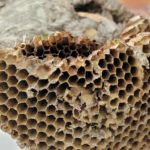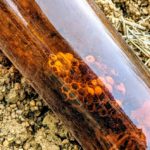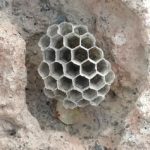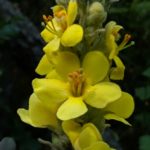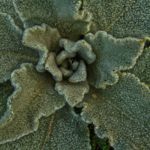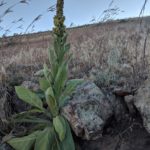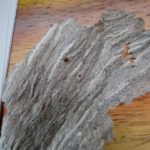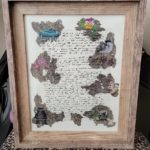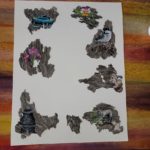Kicking the Hornet’s Nest: Why,When,Where
If you are going to kick a hornet’s nest, it is best to do so in winter. In this case, I am not talking about a metaphorical hornet’s nest, which is unaffected by seasonal change.
I am talking about the real deal, an actual home of hornets, paper wasps, or yellow jackets the most assertive and well armed in the family known as hymenoptera vespidae, or wasp.
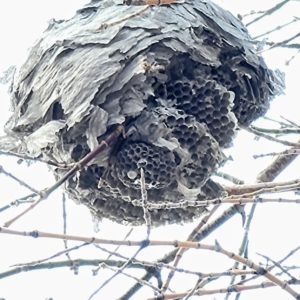 Yes, if you do wish to physically accost an actual hornet’s nest, winter is best. This is because winter is when these structures are most likely to be emptied of their prickly inhabitants.
Yes, if you do wish to physically accost an actual hornet’s nest, winter is best. This is because winter is when these structures are most likely to be emptied of their prickly inhabitants.
Walking along the paved Provo River Park Trail heading east of Johnson’s Hole, it is easy to spy several good sized nest. No longer secreted beneath the leafy ruffles of summer’s skirts, these interesting structures hang from winter barren branches, like mummy wrapped footballs. The hexagonal hatcheries are enfolded in a variegated, D.I.Y. paper as protection from the elements, other winged insects and birds who like to prey upon the defenseless young.
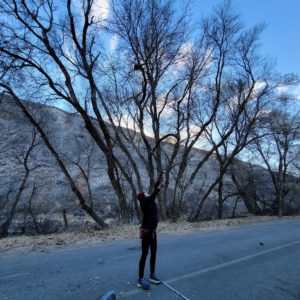
It is this miraculous material that I am after.
Wasps, hornets, yellow jackets…what can I say? Next to tiny Nosferatu -mosquito (see my entry blog entry entitled Midgefly Mitigation) I am not particularly fond of these insects.
Though I haven’t been stung often, the few times I have played the dart board to this insects sharp barb, is more than enough for me. It really hurts! Further more, a wasp sting can lead to residual swelling, soreness, itchiness and just plain misery that can last for days.
The fact is that more than 90% of perceived “bee” stings are actually from, yours truly, the bee’s less bumbling and cuddly cousin, the wasp. This does not make them a popular guest at the pic-nick table, or in the garden or as a hiking companion.
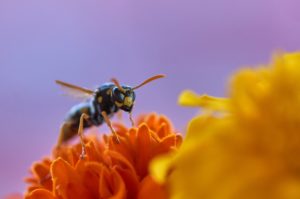 So why write about wasps? The fact is that they really don’t deserve the bad rap they are given. Wasps play an important role in a healthy ecological system. You can check out their many benefits here.
So why write about wasps? The fact is that they really don’t deserve the bad rap they are given. Wasps play an important role in a healthy ecological system. You can check out their many benefits here.
The wasps or hornet that most people associate with painful probes, are social wasps and really only make up about 1,000 species out of the 30,000 varieties. The rest are referred to as solitary wasps and are much less likely to sting, unless seriously provoked.
From the 5 inch long ichneuman wasp to the microscopic Tinkerbell fairy fly, wasps run the variety gambit of shapes, sizes and colors. I recommend listening to this fabulous podcast on Spheksology ( the study of wasps) on one of my favorite nature podcast Ologies .
In this blog, however, I want to relate some of of my own wasp encounters; What I have observed and learned about their remarkable behaviors and what I have found actually works very well if you end up playing the pincushion. OUCH!!!
Pollen Wasps
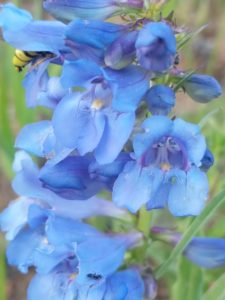
One of the strangest insect behaviors I have run into, is that of the pollen wasp.
Growing along the sandy ravines from June through August, is a beautiful flower known as Wasatch beards tongue penstemon. A few years ago, I happened to stop to admire a some of these blooms, when I noticed what I thought was a familiar yellow and black bum protruding from one of the bell shaped blossoms like nature’s caution tape.
I froze, not wanting to disturb, dislodge or disgruntle this temporary tenant. However, after a few minutes of observing with seeming no effort on the part of the wasp to disengage from this floral garage, I began to get more curious. I carefully pushed the stem of the penstemon to see if the wasp would be encouraged to move on. To my surprise, nothing at all happened!
Hmmmm…curiosity killed the cat, but satisfaction brought it back.
Feeling a little more daring I decided to use a twig to gently prod this flower enamored little creature to see if that might elicit some response… any response. To my surprise, it did not!
Did these penstemon contain a sort of yellow jacket nepenthe or soma? I remember thinking. And how could I garner some in case of future unhappy run ins with less stupefied stingers?
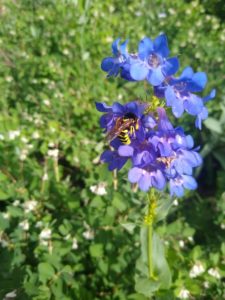
Wasatch Beards-tongue Penstemon
Turns out, however, after a decent amount of digging around, that these florally amorous wasps are not yellow jackets at all, but an entirely different species known as the pollen wasps and of course what they are doing behind their petaled curtain is gathering pollen.
Though as to why they are so completely entranced and entrenched in their activity as to be seemingly oblivious to a human literally hoisting them up their petard, remains to be understood.
So if you are a wasp expert and understand the process of these solitary yellow jacket doppelgangers, I would love to hear more!
A Farewell to Wasps
As I mentioned at the beginning, the reason you should wait until winter to approach a hornets nest for any type of reason is that it is likely to be abandoned.
Where do all the wasps go, you might ask?
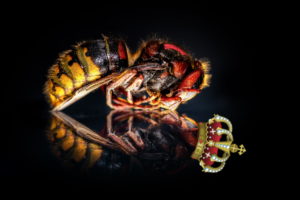
Well, the answer is to die.
All except for the new queens. These fortunate few will leave the nest to shelter in trees or other such dark cozy crevices to wait out the winter. Come spring they emerge like little lady Lazeruses to build a new nest, don their tiny little (metaphorical) crowns and begin their reign as the new queen bee of the wasp colony.
For every other wasp, it is then end of the line. I am going to make a bold (ish) observation here. I think, that often, the end of the line happens to be in a creek-bed. I don’t have any reference for this, just something I have noticed.
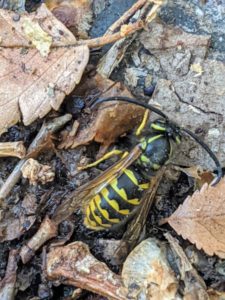
Year after year, in late fall, I have encountered wasps congregating lethargically on the rocks and damp soil of a creek bed ravine. No longer able to fly (much anyway) they seem to be just sort of wandering aimlessly until they succumb to stillness amongst fallen kin.
I am always caught of guard at the amount of empathy I feel for these once fierce and feared little warriors. They too are humbled by the ever sweeping broom of time.
On wasp Stings
Despite what you might think, wasps do not actually fly around looking for tender human skin to prick.
Most of the time a person is stung because they have wandered into nest territory or the wasps feels threatened in some way, such as being swatted at. Better to back away slowly or try to move on with a calm demeanor.
As I mentioned above, a wasp sting is really quite painful! Luckily I’ve only been stung by your average yellow jacket or maybe bald face wasp (they look and act very similar) and not the wasp whose sting is referred to as the “cow killer.”
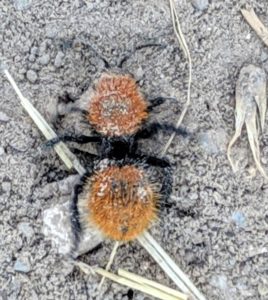
This wasp doesn’t really look like a wasp at all, but instead it resembles a large ant with a luxurious taste in outer wear. For this reason it is known as the velvet ant. I have encountered quite a few in my wanderings.
With gorgeous crimson, azure or silvery coats, these wingless wasps lure unsuspecting humans into thinking they are fuzzy fancy friends. Okay, they don’t actually try to get you to pet them, But, either way do not be fooled or tempted! On the Schmidt’s sting pain index which ranks and describes insects based on one scientists evaluation of stinging insects, it is ranked 3 out of 4.
The good news is that the venom is not high on the toxicity scale and no known deaths have ensued from having been stung by the “cow killer”.
You can watch Coyote Peterson self inflict with a velvet ant on his you tube channel, Brave Wilderness here. Is he crazy? Just a little!!
So what do I do after I’ve been stung by a wasp or hornet? I couldn’t end this blog without a shout out to my favorite and quite effective remedy And that is a poultice made from Common Mullein.
Mullein, (Verbascum thaspus L) grows quite abundant in North America and can be found on sandy hill sides, along fence posts and in ravines, open meadows or abandoned fields. The first year plants form large rosettes of fuzzy oval shaped leaves that measure up to a foot long. The second year plants shoot a stalk straight up into the air that can be as high as 8 feet tall. Though, the ones around here are usally 3 – 4 feet in height. Along this stalk will bloom a beautiful array of creamy yellow flowers. While this plant has amazing healing properties, for many ailments, it is excellent for soothing and healing wasp and other insects stings.
Here’s what to do: Select a good sized clean leaf and mash or bruise with a rock or your hands then apply directly to sting site. You can use a bandage or cloth wrapped around to hold it in place. I like to reapply every few hours. Truly though, this herbal remedy works quickly to help lessen the painful sting and or itching. It’s miraculous!
Beauty and the “Beast”
So why was I collecting a paper wasps nest this past month? For an art project! It turns out these tiny beasties, construct a beautiful medium for painting on, or for other nature inspired projects. My project is a gift that I gave to my mother for her 80th birthday this past week. On sections of wasp paper I painted images from a letter her mother had written about her childhood. Here is the finished project.
I am hoping that by reading this blog, and clicking on the links, I have dispelled some of the negativity that is in the general zeitgeist towards wasps. In reality, these insects are incredibly interesting and creative creatures. Some indigenous cultures even honor the wasps in their mythologies as creator beings and for good reason! Certainly wasp should garner our respect if not our love.

